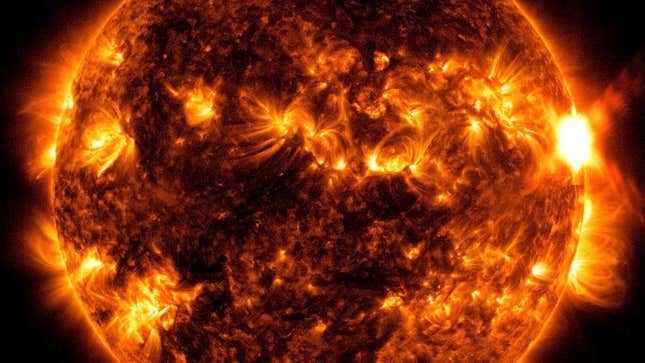
That massive ball of hot gas at the center of our solar system is responsible for keeping our planet nice and balmy, but its also the source of some huge astronomical disruptions. Earlier this week, two enormous solar flares erupted from the Sun, knocking out radio signals across the U.S.
“The X1.5 Flare caused an R3 (strong) radio blackout event on the daylit side of the Earth (most of the US and Canada and the Pacific Ocean),” solar physicist Keith Strong told space.com.
Advertisement
The second solar flare, referred to as a high frequency radio event by the National Oceanographic and Atmospheric Administration, hit Earth on Monday August 7 with peak activity occurring at 4:46 p.m. Eastern Time. According to the administration, the solar flare was dubbed an X1.5 flare, and EarthSky says that X-class solar flares are the most intense family of activity. Effects of the flare included degradation and loss of high frequency radio signals, specifically on the sunlit side of the planet.
Advertisement
Advertisement
“Solar flares are powerful bursts of radiation. Harmful radiation from a flare cannot pass through Earth’s atmosphere to physically affect humans on the ground,” NASA tweeted following Monday’s event. “However—when intense enough—they can disturb the atmosphere in the layer where GPS & communications signals travel.”
Monday’s solar flare was preceded by another solar flare emitted just two days earlier, with activity peaking at 6:21 p.m. Eastern Time on August 5, according to NASA. This solar flare was another X-class event, but was a tad stronger than Monday’s flare, clocking in at an intensity of X1.6.
Related: Mystery Cosmic Storms Left Their Mark in Tree Rings, Scientists Say
Solar flares can effect us here on Earth by impacting our radio signals, but these cosmic storms can also spell disaster for spaceflight. Last September, ESA and NASA’s Solar Orbiter spacecraft was caught in the crosshairs of some of the Sun’s plasma as the star emitted a coronal mass ejection a few days prior. Luckily, Solar Orbiter survived as it was built to withstand the churning heliosphere, but solar storms could be an insurmountable obstacle for unprepared satellite missions.
Services Marketplace – Listings, Bookings & Reviews